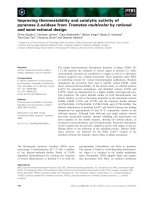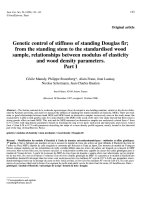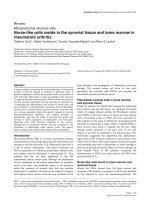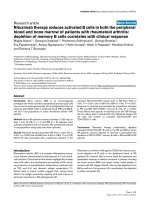Generation of hepatocyte like cells from mouse embryonic stem (ES) and bone marrow (BM) cells
Bạn đang xem bản rút gọn của tài liệu. Xem và tải ngay bản đầy đủ của tài liệu tại đây (1.16 MB, 123 trang )
Generation of Hepatocyte-like cells from Mouse Embryonic
Stem (ES) and Bone Marrow (BM) Cells
YIN YIJUN
NATIONAL UNIVERSITY OF SINGAPORE
2004
1
Generation of Hepatocyte-like cells from Mouse Embryonic
Stem (ES) and Bone Marrow (BM) Cells
YIN YIJUN
A THESIS SUBMITTED
FOR THE DEGREE OF DOCTOR OF PHILOSOPHY OF
MEDICINE
DEPARTMENT OF OBSTETRICS & GYNAECOLOGY
NATIONAL UNIVERSITY OF SINGAPORE
2004
i
DECLARATION
This is to declare that the work reported in this thesis was done solely by the
undersigned candidate, and has not been submitted to any University for admission to a
degree, diploma or other qualification.
Yin Yijun
ii
ACKNOWLEDGEMENT
I would like to express my sincere gratitude to my supervisors Dr Sai Kiang Lim
(Genome Institute of Singapore) and Professor Soon Chye Ng (Department of Obstetrics
& Gynaecology, NUS) for all of their supervision, assistance, encouragement and support
during the course of this project. I would like to thank Dr Manuel Salto-Tellez
(Department of Pathology, NUS) for experimental consultation.
Additional thanks must be extended to laboratory colleagues past and present –
Yew Koon Lim, Shee Han Lee, Keng Suan Yeo, and others for their help with my
experiment during my study.
Worth mentioning is my wife, Yonghong. I would like to say genuinely
gratefulness for her encouragement, understanding and support during my study. Further
extension of my appreciation is to my parents for their spiritual support.
This study was supported by a postgraduate scholarship awarded by The
University of Singapore.
iii
TABLE OF CONTENTS
DECLARATION i
ACKNOWLEDGEMENT ii
TABLE OF CONTENTS iii
LIST OF FIGURES vii
LIST OF TABLES x
ABBREVIATION xi
CONFERENCE AND PAPER xiv
ABSTRACT OF THESIS ENTITLED xv
General Statement 1
1. Liver development 1
2. Causes and treatment of liver failure 3
3. Particular cell response to different liver injury 4
4. Definition and classification of stem cells 6
Part I AFP
+
, ES Cell-Derived Cells Engraft and Differentiate into Hepatocyte-like cells in
vivo 8
Abstract 8
1 Introduction 10
1.1 General statement 10
1.2 Generation and experimental application of ES cell derivatives 10
1.3 Challenges in isolating ES cell derivatives 15
1.4 Specific challenges in isolating ES-derived hepatic progenitor cells 16
1.5 The objectives of the study 17
iv
2 Materials and Methods 18
2.1 Gene Targeting 18
2.2 Maintenance of recombinant ES (rES) cell without differentiation 19
2.3 rES cell differentiation 19
2.3.1 Differentiation in vitro using suspension culture method (Robertson 1987)19
2.3.2 Differentiation in vitro using a modified two-step suspension culture method
(Wiles 1993) 20
2.3.3 Analysis and assortment of GFP expressing cells in differentiated rES cells
by FACS 21
2.3.4 Fluorescent-microscope analysis of rES and D12 differentiated rES cells 21
2.4 Partial Hepatectomy (PHx) and Cell Transplantation 21
2.5 Collection of tissues 24
2.6 β-gal assay – X-gal staining 25
2.7 Immunohistochemistry (IHC) 25
2.8 DNA and RNA extractions and Reverse Transcriptase-Polymerase Chain
Reaction (RT-PCR) analyses 26
2.9 Immunoprecipitation 29
2.10 Western blot analysis 30
3 Results 32
3.1 Modification of ES cells by homologous recombination of GFP gene with AFP
locus 32
3.2 AFP/GFP expression in in vitro differentiated rES cells 34
3.3 Engraftment and differentiation of GFP
+
cells to hepatocyte-like cells 39
v
4 Discussion 47
Part II Derivation of Hepatocyte-like cells from BM cells without Hematopoietic
Reconstitution 52
Abstract 52
1 Introduction 54
1.1 General Statement 54
1.2 Non-hematopoietic cell derivatives from BM cells 54
1.3 The purpose of this study 59
2 Materials and Methods 60
2.1 Preparation of mononuclear cells from BM 60
2.2 Experimental Transplantation 61
2.3 Isolation of NPCs from livers by using modified conventional two-step
collagenase perfusion (Seglen 1973) 63
2.4 Immunohistochemical staining of liver paraffin sections 64
2.5 Assay for serum ApoE in transplanted ApoE-deficient mice by western blot
analysis 65
2.6 Analysis of NPCs by fluoresence microscopy 65
2.7 Isolation of Thy-1
+
and Thy-1
−
cells from Rosa26 BM cells by MACS 66
3 Results 67
3.1 Donor BM cell engraftment in PHx mice 67
3.2 Characterization of BM-derived cells in recipient livers with surface markers 67
3.3 Engrafted BM-derived cell differentiation into hepatocyte-like cells in second
PHx recipients 70
vi
3.4 Derivation of hepatocyte-like cells from BM cells in mice with chronic hepatic
deficiency induced by Fas-mediated apoptosis 73
3.5 BM cell type in generating engrafted Thy-1
+
cells in recipient livers 76
4 Discussion 77
Future study 84
Summary 86
References 87
vii
LIST OF FIGURES
Part I
Figure 1 GFP recombination at the AFP locus 33
Figure 2 Southern blot hybridization of genomic DNA from WT and recombinant
ES (rES) cell clones 33
Figure 3 Fluorescent microscopy of GFP expression in EBs during in vitro
differentiation using suspension culture method 36
Figure 4 rES-derived EBs at day 6 36
Figure 5 FACS analyses of AFP/GFP rES cells by using a two-step in vitro
differentiation method 37
Figure 6 Fluorescent microscopy results in undifferentiated and differentiated ES
cells 37
Figure 7 RT-PCR pictures demonstrate the mRNA expressions of AFP and
Albumin in recombinant and differentiated ES cells 38
Figure 8 The Rosa26 mouse liver (a transgenic mouse) and 129sv mouse liver
(a wild type mouse) were stained with X-gal 41
Figure 9 X-gal and H&E staining showed the teratoma formed by injection of rES
cells into PH× mice 41
Figure 10 Pictures showed the X-gal staining of liver sections from GFP+ cell
transplanted Rosa26 mice that ubiquitously express beta-galactosidase in
all tissue (X-gal staining positive) 44
viii
Figure 11 Genomic DNA was extracted and amplified by PCR from rES-derived
AFP/GFP+ cell transplanted mouse liver samples 44
Figure 12 Immunohistochemical staining showed that albumin and ApoE
expressions could be demonstrated in X-gal negative cells that should be
derived from transplanted AFP/GFP+ cells 45
Figure 13 RT-PCR analysis demonstrated the presence of ApoE or haptoglobin
mRNA in ApoE- or Hp-deficent mice after GFP+ cell transplantation
45
Figure 14 Immunohistochemical staining demonstrated the presence of ApoE in
ApoE-deficent mice after GFP+ cell transplantation 46
Figure 15 Western-blot showed ApoE protein in ApoE-deficient mouse after
AFP/GFP+ cell transplantation 46
Figure 16 Immunoprecipitation and Western-blot analyses showed haptoglobin
protein in Hp-deficient mouse with LPS treatment after GFP + cell
transplantation 46
Part II
Figure 1 liver section from Rosa26 BM transplanted C57BL/6J mice were perfused
and fixed glutaraldehyde and stained by X-gal staining and H&E 69
Figure 2 Immunofluroscent pictures overlaying with transmission picture of β
galactosidase and antibody staining of isolated NPCs from Rosa26 BM
transplanted C57BL/6J mice antibody 69
Figure 3 NPCs are isolated from MTnLacZ mouse BM-transplanted livers and
double stained with β-gal substrate and Thy-1 antibody 70
ix
Figure 4 BM-derived MTnLacZ expressing hepatocyte-like cells 72
Figure 5 BM-derived ApoE+ hepatocyte-like cells in ApoE deficient mouse after
C57BL/6J BM transplantation 72
Figure 6 BM-derived ApoE+ hepatocyte-like cells in ApoE deficient mouse after
FASLPR BM transplantation 74
Figure 7 BM-derived ApoE+ hepatocyte-like cells in ApoE deficient mouse after
FASLPR BM transplantation with series Fas antibody injection 74
Figure 8 Clusters of BM-derived ApoE+ hepatocyte-like cells in ApoE deficient
mouse after FASLPR BM transplantation following series Fas antibody
injection 75
Figure 9 ApoE in ApoE deficient mouse serum was demonstrated by Western-blot
after FASLPR BM transplantation following series Fas antibody injection
75
Figure 10 Immunofluroscent picture overlaying with transmission picture of β
galactosidase and Thy-1 antibody staining of isolated NPCs from
transplantation of MACS-sorted Rosa 26 BM Thy-1+ and Thy-1 cells
76
x
LIST OF TABLES
Table 1 Table shows the yield and viability of whole cell population and GFP
positive cells in in vitro differentiation medium with or without hepa-
condition media 38
xi
ABBREVIATION
α-1 ATT α-1 antitrypsin
β2m
−
β-2-microglobulin-negative
β-gal β-galactosidase
AFP α-fetoprotein
ApoE apolipoprotein E
BM bone marrow
BMPs bone morphogenetic proteins
CIA chloroform, isoamyl alcohol
DAB 3,3’-diaminobenzidine
DEPC diethyl pryrocarbonate
DMEM Dulbecco’s modified Eagle’s medium
DTT dithiotheritol
EBs embryoid bodies
ECS Enhanced Chemiluminescent Substrate
EG cells embryonic germ cells
ES cells embryonic stem cells
FACS fluorescence-activated cell sorting
FAH fumarylacetoacetate hydrolase
FBS fetal bovine serum
FGF fibroblast growth factor
G-CSF granulocyte colony-stimulating factor
GFAP glial fibrillary acidic protein
xii
GFP green fluorescence protein
GI tract gastrointestinal tract
GITC guanidinium thiocyanate
HGF hepatocyte growth factor
HNF3β hepatocyte nuclear factor 3β
Hp haptoglobin
HRP horseradish peroxidase
HSCs hematopoietic stem cells
IHC immunohistochemistry
IL-6 interleukin-6
IMDM Iscove’s modified Dulbecco’s medium
LDL low density lipoprotein
LIF leukemia inhibitory factor
MACS magnetic activated cell sorting
MAPCs multipotent adult progenitor cells
MEF mouse embryonic fibroblasts
MSCs mesenchymal stem cells
NPCs non-parenchymal cells
OSM oncostatin M
PBS phosphate buffered saline
PCR polymerase chain reaction
PERV porcine endogenous retrovirus
PHx partial hepatectomy
xiii
PI propidium iodide
rES cells recombinant ES cells
RT-PCR reverse transcriptase PCR
SCF stem cell factor
SDS sodium dodecyl sulfate
SHPC small hepatocyte-like progenitor cell
TAT tyrosine aminotransferase
TNF-α tumor necrosis factor-α
TPI triose phosphate isomerase
VEGF vascular endothelial growth factor
xiv
CONFERENCE AND PAPER
1. Yin Y, Chow PH and O WS (1998) Effects of Male Accessory Sex Glands on the
Distribution of Endometrial Lymphocyte and Macrophage in Golden Hamster
after Mating in vivo. Journal of Reproduction and Fertility. Abstract series 21, 96
2. Yin Y, Lim YK, Salto-Tellez M, Ng SC, Lin CS, Lim SK (2002) AFP(+), ESC-
derived cells engraft and differentiate into hepatocytes in vivo. Stem Cells 20(4):
338-46
3. Yin Y, Que J, Teh M, Ping Cao W, Menshawe El Oakley R, Lim SK (2004)
Embryonic Cell Lines With Endothelial Potential: An In Vitro System for
Studying Endothelial Differentiation. Arterioscler Thromb Vasc Biol. 2004 Feb 5
[Epub ahead of print]
xv
ABSTRACT OF THESIS ENTITLED
Generation of Hepatocyte-like cells from Mouse Embryonic Stem (ES) and Bone
Marrow (BM) Cells
The paucity of hepatocytes available for hepatocyte replacement therapy requires
consideration of alternatives such as embryonic stem (ES) cell-derived hepatic
progenitors or BM cells. Here, Green fluorescent protein (GFP) was knocked into the α-
fetal protein (AFP) locus of mouse ES cells to facilitate isolation of AFP
+
hepatocyte-like
progenitors that differentiated into hepatocyte-like cells in vivo and expressed albumin,
haptoglobin and apolipoprotein-E. In addition, intrasplenic transplantation of BM cells in
mouse models of hepatic deficiency can generate hepatocyte-like cells at low frequency.
These cells can be amplified to a therapeutic level when given a selective advantage over
host hepatocytes in a sufficiently chronic hepatic deficient microenvironment. This thesis
proposes that both ES cells and BM are viable alternative cell sources in the cell
replacement therapy for liver diseases.
Keywords: hepatocytes, Embryonic Stem Cells, Bone Marrow, transplantation
1
General Statement
1. Liver development
The liver is the first glandular structure that differentiates in mammal embryonic
development. It develops and originates from endodermal germ layer. The endoderm
germ layer derives from the epiblast during gastrulation. It differs from the visceral
endoderm, which arises from a non-embryonic lineage. It is called the definitive
endoderm, which initially lines the ventral surface of the embryo (Zaret 2001). Anterior
and posterior invaginations of definitive endoderm subsequently develop the embryonic
foregut and hindgut pockets, from day 7.5 to 8.5 of embryonic gestation (E7.5-8.5) of the
mouse (Zaret 2001). The anterior-ventral domain of the foregut endoderm, from E8.5-9.5,
develops buds for the liver. This outgrowing bud of proliferating endodermal cells present
in the ventral floor of the foregut can be identified morphologically in development of
liver (Duncan 2003). After E7.5, the mesoderm exposed to endoderm can instruct
endoderm to form anterior/posterior patterning and make endoderm competent to become
hepatic cells by express several hepatic markers (Zaret 2000). By E8.5, fibrolast growth
factor 1 (FGF1) and FGF2 from cardiac mesoderm can induce the foregut endoderm to
the hepatic lineage (Jung, Zheng et al. 1999). By E9-10, bone morphogenetic proteins
(BMPs) from septum transversum mesenchyme induce the liver specific transcription
factor, GATA4, in the foregut endoderm prior to hepatogenesis (Rossi, Dunn et al. 2001).
Both GATA4 and hepatocyte nuclear factor 3β (HNF3β) are essential for hepatic
specification and for downstream events leading to hepatocyte differentiation, such as
inducing the expression of hepatocyte specific protein albumin (Ang, Wierda et al. 1993;
Bossard and Zaret 1998; Rossi, Dunn et al. 2001). From E8.5 to 10.5, endothelial cells
2
between hepatic endoderm and septum transversum mesenchyme can mediate and induce
liver bud cells to express albumin (Matsumoto, Yoshitomi et al. 2001). But the key
factors from endothelial cells have not been identified yet. At E11.5, both hepatocyte
growth factor (HGF) and its receptor cMet are detectable in the liver tissue. HGF can
control the fetal liver cells proliferation and maturation (Sonnenberg, Weidner et al. 1993;
Duncan 2003). At E14.5, oncostatin M (OSM) secreted by haematopoietic stem cells
(HSCs) in liver has the effect on proliferation and maturation for fetal hepatocytes
(Kinoshita, Sekiguchi et al. 1999). During embryonic development, it is crucial that the
various differentiated hepatic cell types combine with extracellular components and
connective tissues to generate a functional hepatic infrastructure (Duncan 2003). The
process of differentiation of hepatoblast to hepatocyte is gradual, taking several days
during the rodent embryo development. Electron microscopy of fetal rat tissues showed
that the hepatoblast cells transit from an oblong shape at E12-14 to spherical around E18
and finally become polygonal just prior to birth on E20 (Vassy, Kraemer et al. 1988).
The liver accounts for one fiftieth of the total body weight in adult. It receives
venous blood directly from the intestine, spleen and pancreas. As such, it encounters a
diverse array of toxins, nutrients and hormones (Duncan 2003). Reflecting the anatomical
and physiological properties, the liver performs endocrine functions that condition the
blood through detoxification and the secretion of serum factors. In addition to its
endocrine activity, the liver also exhibits an exocrine function through the generation of
bile (Duncan 2003). In the cellular composition, approximately 60% of the cells in the
adult rat liver are hepatocytes, while the remaining cells consist largely of cholangiocytes,
Kuppfer cells, stellate cells, and a variety of endothelial cells including those lining the
3
sinusoid (sinusoidal endothelial cells) (Blouin, Bolender et al. 1977). The architecture of
the liver is absolutely critical for normal liver function and is often severely affected
during chronic liver injury (Friedman 2000).
2. Causes and treatment of liver failure
Serious liver disease has many causes, such as viral hepatitis, drug toxicity
(paracetamol overdose), environmental toxin, alcohol, metastatic malignancy, inherent
genetic defect, etc. The disease outcome generally depends on the extent of functional
hepatic compromise and the ability of undamaged hepatocytes to replicate and replace
diseased parenchyma with many cases progressing to end-stage liver failure when liver
functional capacity drops below a critical level (Tilles, Berthiaume et al. 2002). In
fulminant hepatitis, survival rate is 15-25% when treated with conservative medical
measures. In most case, survival is measured in days and hours, and death in weeks
(Bernuau, Rueff et al. 1986). Orthotopic liver transplantation remains the only established
successful treatment to reverse the severe liver dysfunction and terminal liver failure. 60-
75% of liver failure can be rescued by liver transplantation (Lidofsky 1993).
Unfortunately, this treatment has severe limitations such as tissue compatibility, size
discrepancy, use of medication, age, preexistent disease, and most notably, the paucity of
liver donors. Therefore, mortality rates for liver failure remain high.
Many devices including bio-artificial liver device have been developed in order to
provide temporary liver support for patients with acute liver failure to either allow liver
regeneration or await liver transplantation. Unfortunately, to date, these systems have not
been able to improve the clinical status of the patient with liver failure (Tilles,
Berthiaume et al. 2002). Furthermore, the use of hepatoma cell lines or porcine
4
hepatocytes in some of bio-artificial liver devices raises the possibility of side effects like
transmigration of tumor cells to patients or pig-to-human transmission of activated
porcine endogenous retrovirus (PERV) (Stockmann and JN 2002).
Recently, transplantation of a small number of genetically normal hepatocytes in
both animal models (Braun, Degen et al. 2000) and human patients (Strom, Chowdhury et
al. 1999) were shown to be sufficient in correcting liver disease caused by certain inborn
errors of metabolism leading to the proposal that transplantation of healthy hepatocytes
into diseased liver may be an alternative therapy (Gupta, Malhi et al. 1999). Under these
circumstances, therapy may not require proliferation of donor cells but only their
persistence. However, this procedure is also severely limited by a shortage of donor
organs necessary for the isolation of human hepatocytes. Furthermore, this procedure is
not suitable for patients requiring replacement of a large portion of the diseased
parenchyma by donor cells as transplantation of a large number of hepatocytes into the
spleen or portal vein may cause portal hypertension and parenchymal ischemia (Braun,
Degen et al. 2000). Therefore, it was suggested that for hepatocyte or cell transplantation
to be a viable therapeutic option to replace sufficient liver parenchyma in the treatment of
liver diseases, proliferation of donor cells after transplantation is a necessary prerequisite
and in this regard, hepatic stem cells and/or progenitor cells are ideal candidates.
3. Particular cell response to different liver injury
The restitutive response of the liver to different injuries involves proliferation of
cells at different levels in the liver lineage. It was postulated recently that there are three
levels of proliferating cells in the liver (Sell 2001). First is mature hepatocyte. In the
classic partial hepatectomy (PH×) experiment, the loss of two thirds of the rat liver is
5
replaced by proliferation of hepatocytes. 95% of the hepatocytes of young animals
replicate between 12 to 48 hours in rat and 30 to 60 hours in mice (Fausto and Campbell
2003). The mature hepatocytes have “unlimited” replicative potential on damage liver
repopulation (Rhim, Sandgren et al. 1994; Overturf, Al-Dhalimy et al. 1996). There was
little or no evidence of involvement of a liver stem cell (Sell 2001; Fausto and Campbell
2003). The second is intrahepatic stem cell. The canals of Hering in anatomic liver
architecture presumably constitute the stem cel niche in adult liver. The presumed
progeny of stem cells, oval cells, are not detectable in normal liver but abundantly
proliferate, probably as an amplifying transit compartment after stem cell activation. This
cell proliferation is prominent in many models of liver injury including carcinogenesis
(azo-dyes, etc), injury caused by D-galactosamine, dipin, etc (Sell 2001). These cells are
immunoreactive to α-fetal protein (AFP), and to antibodies generally associated with
haematopoietic lineage, such as Thy-1, CD34 and c-kit (Omori, Evarts et al. 1997; Omori,
Omori et al. 1997; Petersen, Goff et al. 1998). There is still another type of cell referred to
as “small hepatocytes” (small hepatocyte-like progenitor cell or SHPC) that is apparently
responsible for the regeneration of rat liver after PH in animals exposed to retrorsine
(Gordon, Coleman et al. 2000; Gordon, Coleman et al. 2000). SHPCs express some
hepatocyte markers but represent a less differentiated population that is phenotypically
distinct from hepatocytes (Gordon, Coleman et al. 2000). The location of these cells in
the liver is unknown at this time. The third is a multipotent stem cell in the liver derived
from circulating bone marrow (BM) stem cells. Since the oval cells and hepatocytes from
HSCs can be generated (Petersen, Bowen et al. 1999; Alison, Poulsom et al. 2000;
6
Theise, Badve et al. 2000). The capacity of haematopoietic stem cell (HSC) to generate
cellular lineages in the adult liver is an arguing subject currently.
4. Definition and classification of stem cells
What is a stem cell? A stem cell is a cell from the embryo, fetus, or adult that has,
under certain conditions, the abilities to self-renew and to give rise to specialized cells
that make up the tissues and organs of the body. In general, there are three types of stem
cells defined by their origins.
An embryonic stem (ES) cell is an undifferentiated, and pluripotent cell derived
from the inner cell mass of blastocyst (Evans and Kaufman 1981; Martin 1981). The first
ES cell cultures to be established were murine ES cells. They have two distinguishing
features. When cultured on feeder-cell layers of mouse embryonic fibroblasts, or in the
presence of leukemia inhibitory factor (LIF), ES cells maintain their undifferentiated
phenotype and unlimited self-renewal capacity. Removal of the feeder-cell layer and
withdrawal of LIF induce spontaneous differentiation of ES cells into cells representative
of all three germ layers. When transplanted into an early embryo, they can contribute to
all somatic cells of the embryo and germ cells, but not to the placental tissue (Bradley,
Evans et al. 1984). In 1995, ES cells from nonhuman primates were isolated (Thomson,
Kalishman et al. 1995). The derivation of human ES cell lines followed shortly
(Thomson, Itskovitz-Eldor et al. 1998; Reubinoff, Pera et al. 2000).
The second type of stem cell is embryonic germ (EG) cells isolated from the
primordial germ cells of the gonadal ridge of the fetus (Matsui, Zsebo et al. 1992). In
most aspects, they are indistinguishable from blastocyst-derived ES cells. Mouse EG cells
when transferred into blastocysts can efficiently form chimeras and contribute to germline
7
(Labosky, Barlow et al. 1994; Stewart, Gadi et al. 1994). Derivation of human EG cells
from aborted fetus has also been reported (Shamblott, Axelman et al. 1998).
The third type of stem cell is the adult stem cells. Like ES and EG cells, adult stem
cells can self-renew, but unlike ES and EG cells, they give rise to specific sets of mature
cell types. Adult stem cells have been found in many adult tissues e.g. bone marrow
(BM), brain, epithelia of the skin and digestive system, etc.
8
Part I AFP
+
, ES Cell-Derived Cells Engraft and Differentiate
into Hepatocyte-like cells in vivo
Abstract
The self-renewal ability and pluripotency of embryonic stem (ES) cell have made
it a potential source of cells for stem cell transplantation, gene therapy and tissue
engineering. However, differentiating ES cells into specific tissue stem cells or cell types
remains a major challenge in practical applications of ES cells. To isolate putative liver-
specific progenitor cells, a green fluorescent protein (GFP) gene was inserted into the α-
fetoprotein (AFP) locus of ES cells by homologous recombination such that after
differentiation, differentiated ES cells that expressed AFP will also express GFP. These
differentiated cells were isolated by fluorescence-activated cell sorting (FACS), and
transplanted intrasplenically into partially hepatectomized (PHx) lacZ-positive ROSA26
mice, apolipoprotein-E (ApoE)- or haptoglobin (Hp)- deficient mice. We demonstrated by
immunohistochemistry that these AFP
+
/GFP
+
cells engrafted and differentiated into
albumin- and ApoE-positive hepatocytes. In Hp- and ApoE-deficient mice, these cells
differentiated into Hp- and ApoE-positive hepatocytes that secreted Hp or ApoE protein
into serum, respectively. In conclusion, our experiments demonstrated that hepatocyte-
like progenitor cells could be purified from in vitro differentiated ES cells using AFP as a
marker, and these cells can differentiate into hepatocyte-like cells with some hepatocyte
functions in vivo. (Yin Y, Lim YK, Salto-Tellez M, Ng SC, Lin CS and Lim SK. Stem
Cells 2002; 20:338-346)









